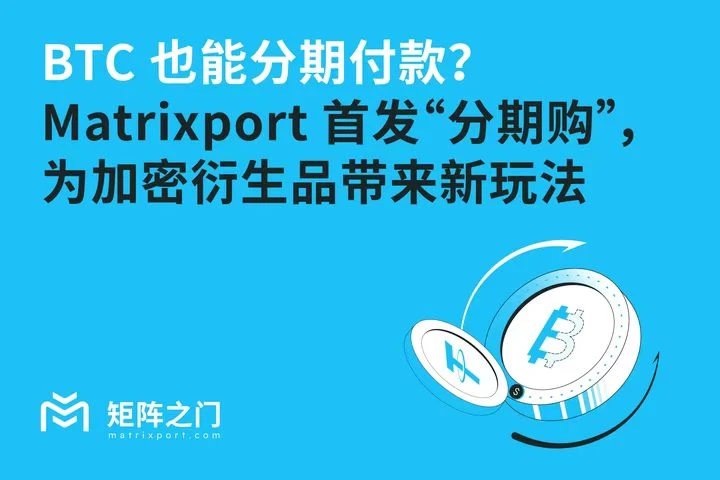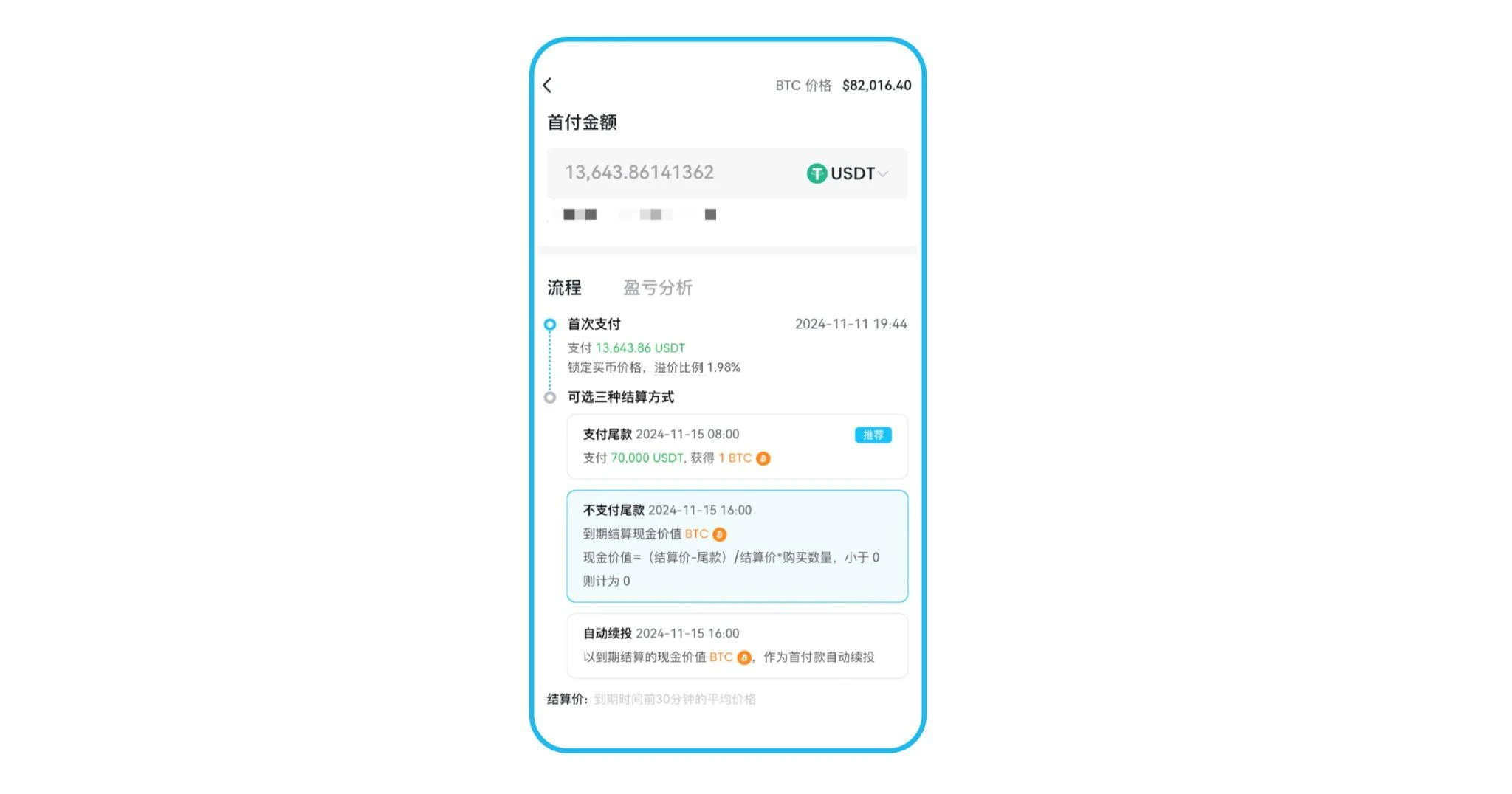
In early November, Matrixport announced the global launch of the structured product "Installment Purchase," which raised over $5 million in just one week, gaining popularity among the market and investors. Official information shows that through the "Installment Purchase" product, investors can use small amounts of capital to purchase and lock in all future returns of the investment targets (BTC or ETH). Investors can enjoy the leverage effect without needing to add margin, only needing to decide whether to pay the final payment based on the actual price of the target at maturity to exchange for the investment target.
From this, we can derive the following keywords for "Installment Purchase": “enjoy leverage effect,” “no need to add margin,” “decide whether to exercise after product maturity.” The fact that no additional margin is required has already solved countless pain points for investors. Coinglass data shows that on November 14, the total contract open interest across the network was approximately $99.45 billion, with $831 million liquidated in 24 hours, affecting both long and short positions, with long liquidations at $497 million and short liquidations at $334 million (real-time data as of November 14, 10:40). In the context of the Trump market, the volatility of the crypto market has further increased, so is "Installment Purchase" capturing investors' hearts by allowing them to avoid liquidation risks and not needing to add margin before the product matures? In fact, this is just one of its advantages.
To provide investors with firsthand investment information, we deeply experienced Matrixport's "Installment Purchase" product and conducted a comprehensive analysis of the financial derivative prototype of "Installment Purchase," the product principles, product advantages, and potential risks, helping you quickly understand the hottest crypto structured financial product "Installment Purchase."
I. Warrants, the traditional financial derivative prototype of "Installment Purchase," favored by traditional investors
Warrants have a history of over 100 years and are a fundamental product of financial derivatives
In 1911, the American Light & Power Company was the first to issue and use warrants, which have developed over the past century. The essence of a warrant is a contract for the purchase of an option, where the party paying the premium for the warrant has the right (but not the obligation) to buy (or sell) a predetermined quantity of the underlying asset at a predetermined price within a specified future period or at expiration. This underlying asset can be local stocks, foreign stocks, baskets of securities, index shares, bonds, currencies, commodities, etc.
The essence of a warrant is the buying and selling of an option. Due to its advantages such as financing convenience, risk hedging, and high leverage, warrants have been widely accepted and rapidly developed in the market over the past 40 years. Statistics show that by the end of 2000, among the 55 member exchanges of the International Securities Exchange Federation (FIBV), 42 exchanges had launched stock warrants.
Installment payment warrants are the most popular type of warrants on the ASX and are used by Australian pension funds
Established in 1991, the Australian warrant market has become one of the most popular warrant markets in recent years. Initially, Australia only had stock subscription warrants, but the variety gradually expanded to include installment payment warrants, structured warrants, exchange-traded warrants, knock-out warrants, commodity warrants, and more. Installment payment warrants are the most popular type of warrants on the Australian Securities Exchange (ASX) and are one of the few leveraged investment tools available to Australian pension funds.
Installment payment warrants allow investors to pay a certain percentage of the underlying asset's value as a down payment to gain exposure equivalent to the underlying security, granting investors the right to choose to pay the final payment (or not) on a future agreed date.
II. Detailed explanation of Matrixport's globally launched crypto structured product - Installment Purchase
The basic principle of the "Installment Purchase" product
"Installment Purchase" combines crypto assets with the traditional financial investment tool "installment payment warrants," allowing investors to lock in potential returns of crypto assets in advance through installment payments, with flexible settlement methods at maturity. Investors can choose to pay the final payment to obtain the full share of the investment target, or not pay the final payment and directly settle in cash value, or extend the term based on the current cash value.
We can roughly understand the "Installment Purchase" product as an upgraded version of "installment home buying," where investors pay a down payment to lock in future returns of the property. When it comes time to pay the final payment, if the property price continues to rise, investors can choose to pay the final payment to obtain the property, or not pay the final payment and directly settle the "return" (cash value). If the property price drops at maturity, users can choose not to pay the final payment, settle the cash value, and exit, or choose not to pay the final payment and not exit, but instead select a new project from the builder and use the cash value as a new down payment to lock in future returns of the new project.
For example, an investor uses USDT to pay a down payment equivalent to 0.2 BTC to lock in 1 BTC, and at maturity can choose to pay the final payment to obtain 1 BTC, or choose not to pay the final payment for cash value settlement or extension.
Actual case demonstration of installment purchase returns
To provide an intuitive demonstration, we will conduct a case study: On November 11 at 19:45, the price of BTC was $82,016.40. If an investor purchases a BTC installment purchase product expiring on the 15th, with a down payment of $13,643.86 and a final payment of $70,000.

Assuming the settlement price of BTC at the expiration of the product on the 15th is $95,000.
Scenario 1: Pay the final payment of $70,000 to obtain 1 BTC (assuming the investor sells BTC immediately after receiving it)
The actual profit obtained by the investor in 3.8 days = 95,000 - 70,000 - 13,643.86 = $11,356.14
The return rate over 3.8 days = 11,356.14 / 13,643.86 * 100% = 83.2%
APY = 3.8 days' return rate / 3.8 * 365 = 83.2% / 3.8 * 365 = 7991.578%
Scenario 2: Do not pay the final payment, settle in cash value (assuming the investor sells BTC immediately after receiving it)
Cash value obtainable = (95,000 - 70,000) / 95,000 * 1 = 0.2631 BTC
The actual profit obtained by the investor in 3.8 days = 95,000 * 0.2631 - 13,643.86 = $11,350.64
Since the final payment was not made, we will compare the spot and installment purchase products:
Assuming the investor purchases the same amount of spot BTC ($13,643.86) at the price of $82,016.40 on November 11 at 19:45:
The amount of spot BTC obtained by the investor = 13,643.86 / 82,016.40 = 0.16735 BTC
When the BTC price is $95,000, the value of the corresponding amount of BTC = 95,000 * 0.16735 = $15,898.25
The profit obtained by the investor from spot BTC = 15,898.25 - 13,643.86 = $2,254.39
Under the same conditions, the return on the installment purchase product purchased with the same amount is (11,356.14 - 2,254.39) / 2,254.39 = 4.0373 times higher than that of spot BTC.
Scenario 3: Do not pay the final payment, extend cash value
Investors can choose to use the settled cash value as the down payment for the next "Installment Purchase" product, entering the next round of investment.
In the current context, using the obtained cash value = (95,000 - 70,000) / 95,000 * 1 = 0.2631 BTC as a down payment to start the next round of installment purchase products.
"Installment Purchase" effectively provides investors with a low-risk leveraged product. The leverage effect arises because the cost of installment payments is lower than the cost of fully purchasing a share; generally, the higher the final payment, the higher the leverage ratio. The "Installment Purchase" product currently offers nearly 10 times leverage for purchasing investment targets, and users do not need to add margin after purchase.
At the same time, the characteristics of installment payments and diverse settlement methods allow investors to achieve the same asset allocation goals with less capital, while the saved money can be used to invest in other investment targets, thereby improving the overall capital utilization rate of asset allocation, achieving diversified investment, spreading risks, and maximizing returns.
Reasonable understanding of potential risk points of the "Installment Purchase" product
Continuing with the above "Installment Purchase" product case, assuming the settlement price of BTC at the expiration of the product on the 15th is $80,000.
In the scenario where the BTC price drops, if the investor does not pay the final payment and directly settles in cash value:
Cash value obtainable = (80,000 - 70,000) / 85,000 * 1 = 0.125 BTC
Investor asset loss = 13,643.86 - 80,000 * 0.125 = 3,463.86 USDT
In summary, we can summarize the potential risks of the "Installment Purchase" product into the following two points:
Price fluctuation risk: Using the "Installment Purchase" product to buy investment targets (such as BTC or ETH) faces the same price fluctuation risk as purchasing spot assets, influenced by market liquidity, FOMO sentiment, and macro factors. If the price declines, users may face asset loss risks, and investors can reasonably allocate bearish tools to hedge risks.
Leverage risk: The "Installment Purchase" effectively provides investors with a low-risk leveraged product. When investors' expectations for the underlying asset are correct, they will gain leveraged returns; conversely, if wrong, investors will also bear leveraged losses. However, leveraged losses are limited, with losses confined to the down payment.
III. Matrixport's global launch of the "Installment Purchase" product brings new gameplay to crypto financial derivatives
As a well-established one-stop crypto financial service platform, crypto asset management products have always been a strong suit for Matrixport, especially in the structured product sector. Matrixport led the launch of the "dual currency" product in 2019, sparking a wave of structured financial products, and five years later, the launch of "Installment Purchase" has brought Matrixport back into the market spotlight. As a fundamental product in traditional derivative financial tools, introducing the concept of warrants into the crypto world not only enriches the current ecosystem of crypto financial derivatives but also facilitates the integrated development of crypto finance and traditional finance.
Currently, Matrixport's structured products are flourishing, covering dual currency, snowball, shark fin, trend smart profit, seagull, installment purchase, and more, catering to a range of investors from low-risk preferences to aggressive investors. Matrixport's asset management and custody volume has reached $6 billion.
Matrixport's asset management team members revealed to reporters that some brand new structured products are already in the product development stage. We are looking forward to what kind of structured products Matrixport will launch next, and we hope Matrixport can continue to be a leader in the crypto asset management sector, helping investors capture rational returns.
免责声明:本文章仅代表作者个人观点,不代表本平台的立场和观点。本文章仅供信息分享,不构成对任何人的任何投资建议。用户与作者之间的任何争议,与本平台无关。如网页中刊载的文章或图片涉及侵权,请提供相关的权利证明和身份证明发送邮件到support@aicoin.com,本平台相关工作人员将会进行核查。



